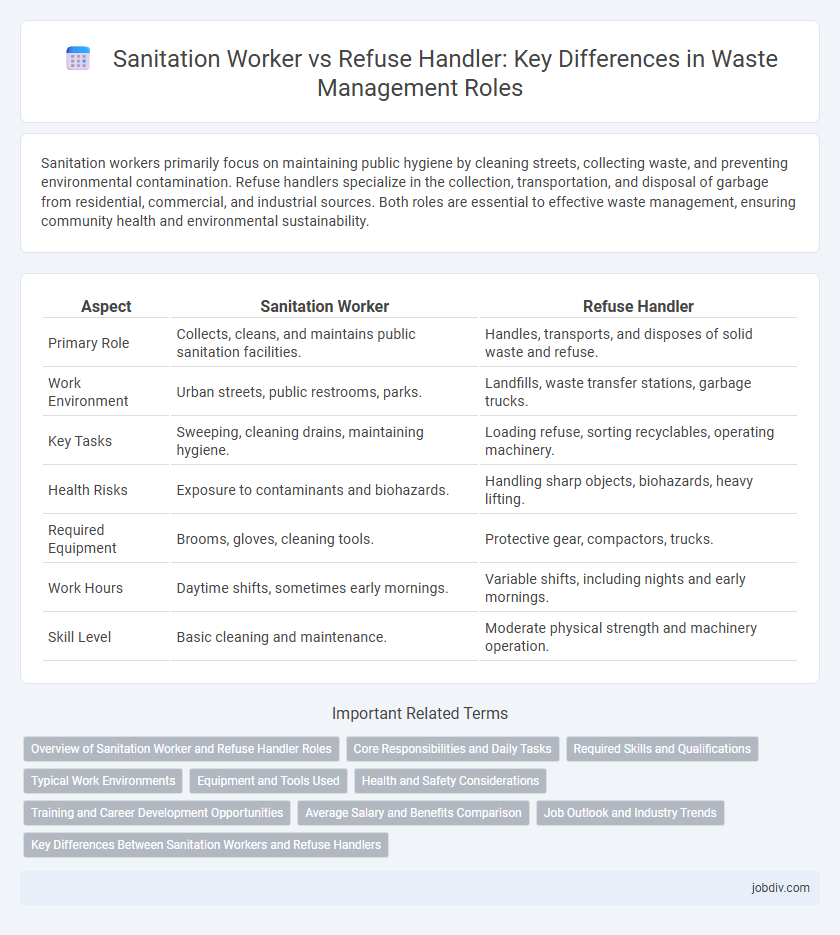Sanitation workers primarily focus on maintaining public hygiene by cleaning streets, collecting waste, and preventing environmental contamination. Refuse handlers specialize in the collection, transportation, and disposal of garbage from residential, commercial, and industrial sources. Both roles are essential to effective waste management, ensuring community health and environmental sustainability.
Table of Comparison
| Aspect | Sanitation Worker | Refuse Handler |
|---|---|---|
| Primary Role | Collects, cleans, and maintains public sanitation facilities. | Handles, transports, and disposes of solid waste and refuse. |
| Work Environment | Urban streets, public restrooms, parks. | Landfills, waste transfer stations, garbage trucks. |
| Key Tasks | Sweeping, cleaning drains, maintaining hygiene. | Loading refuse, sorting recyclables, operating machinery. |
| Health Risks | Exposure to contaminants and biohazards. | Handling sharp objects, biohazards, heavy lifting. |
| Required Equipment | Brooms, gloves, cleaning tools. | Protective gear, compactors, trucks. |
| Work Hours | Daytime shifts, sometimes early mornings. | Variable shifts, including nights and early mornings. |
| Skill Level | Basic cleaning and maintenance. | Moderate physical strength and machinery operation. |
Overview of Sanitation Worker and Refuse Handler Roles
Sanitation workers are responsible for maintaining public cleanliness by collecting, transporting, and disposing of waste materials, often working in both residential and commercial areas. Refuse handlers specialize in the manual handling and sorting of waste, focusing primarily on loading and unloading refuse to facilitate efficient waste management processes. Both roles are critical for ensuring community health and environmental sanitation through effective waste collection and disposal.
Core Responsibilities and Daily Tasks
Sanitation workers primarily focus on the collection, transportation, and disposal of residential and commercial waste, ensuring cleanliness and public health in urban environments. Refuse handlers specialize in sorting, separating recyclable materials from general waste, and preparing refuse for recycling processes to reduce landfill impact. Both roles involve physically demanding tasks but differ in their emphasis on waste management stages, with sanitation workers handling waste removal and refuse handlers concentrating on material recovery and processing.
Required Skills and Qualifications
Sanitation workers require skills in operating specialized cleaning equipment, understanding waste collection routes, and adhering to safety protocols to manage residential and commercial waste efficiently. Refuse handlers need physical endurance, knowledge of waste segregation, and experience with heavy lifting and compacting machinery to handle large volumes of industrial and bulky waste. Both roles demand attention to detail, compliance with health regulations, and the ability to work in varying weather conditions.
Typical Work Environments
Sanitation workers typically operate in urban and residential areas, managing waste collection, street cleaning, and sewage maintenance to ensure public health and environmental cleanliness. Refuse handlers often work in diverse settings such as landfills, recycling centers, and waste transfer stations, where they sort, compact, and manage refuse for proper disposal or recycling. Both roles require navigation of outdoor environments, often involving manual labor and adherence to strict safety protocols.
Equipment and Tools Used
Sanitation workers primarily utilize equipment such as high-pressure washers, protective gloves, masks, and brooms to clean public areas and ensure hygiene. Refuse handlers rely on tools like garbage trucks, compactors, hand trolleys, and waste collection bins to efficiently gather and transport refuse. Both roles demand specialized equipment tailored to waste management and environmental sanitation protocols.
Health and Safety Considerations
Sanitation workers face significant health risks such as exposure to harmful pathogens, sharp objects, and hazardous chemicals, requiring stringent use of personal protective equipment (PPE) and adherence to safety protocols. Refuse handlers also encounter dangers from heavy lifting and operating machinery, necessitating ergonomic training and proper handling techniques to prevent musculoskeletal injuries. Both roles demand continuous health monitoring and workplace hazard assessments to ensure compliance with occupational safety regulations and minimize accidents.
Training and Career Development Opportunities
Sanitation workers typically undergo municipal or specialized sanitation training programs that emphasize public health, waste collection, and hazardous material handling, offering clear pathways to supervisory roles and certifications in waste management. Refuse handlers receive focused instruction on landfill operations, recycling processes, and heavy machinery operation, with career development opportunities leaning towards equipment maintenance and environmental compliance positions. Both roles demand ongoing education to meet evolving safety standards and environmental regulations, supporting advancement within waste management sectors.
Average Salary and Benefits Comparison
Sanitation workers typically earn an average salary ranging from $30,000 to $45,000 annually, with benefits often including health insurance, paid leave, and retirement plans. Refuse handlers generally receive a slightly higher average salary, between $35,000 and $50,000 per year, along with similar benefits such as hazard pay and overtime opportunities. Both roles provide essential services in waste management but differ in compensation and benefit structures based on job risks and responsibilities.
Job Outlook and Industry Trends
Sanitation workers and refuse handlers both play crucial roles in waste management, with job outlooks influenced by increasing urbanization and strict environmental regulations driving demand. The waste industry trends indicate a shift toward automation and sustainable waste processing, impacting job responsibilities and skill requirements. Growing emphasis on recycling and waste diversion programs also creates opportunities for specialized refuse handlers in commercial and residential sectors.
Key Differences Between Sanitation Workers and Refuse Handlers
Sanitation workers primarily focus on maintaining cleanliness in public areas through sweeping, cleaning streets, and managing wastewater treatment, while refuse handlers are specialized in collecting, transporting, and disposing of solid waste materials from residential and commercial sites. Sanitation workers often engage in broader environmental hygiene tasks, including the maintenance of public restrooms and storm drains, whereas refuse handlers operate heavy machinery to manage garbage bins and compactors. The key difference lies in the scope of their duties: sanitation workers ensure overall sanitation infrastructure, whereas refuse handlers concentrate on waste collection and landfill operations.
Sanitation Worker vs Refuse Handler Infographic

 jobdiv.com
jobdiv.com